An Extraordinary Life - Constance Charlotte Bailward (1890 to 1970)
To commemorate the centenary of the start of the First World War, Wincanton Museum mounted an exhibition in Wincanton Library and its centrepiece has been a display of the drawings by a young nurse, Constance Bailward.
All we in the Museum knew about her was that a few years earlier her record-card and sketchbook had been entrusted to the Museum by her son, who still owned a cottage near Horsington.
Our researches revealed that Constance lived with her parents in Horsington Manor and that in 1914 she travelled daily to the Red Cross Hospital in Wincanton. The hospital was housed in the Carmelite Friary (now converted into flats) that stood behind the Catholic Church and there she worked as an auxiliary1 nurse tending the burnt, gassed, shell-shocked and overwhelmingly young casualties of the First World War.
The round-trip of ten miles on unmade roads by horse and trap must have been quite a journey!
The official record-card shows her hours on duty and her sketchbook is filled with pencil drawings and plans for an illustrated alphabet, portraying everyday events in the hospital. It was compiled for the encouragement and amusement of those she worked with, at a time and in a place that must have been extremely demanding. The rhymes, captions and bold, stylish drawing reveal a sensitive, humorous and deeply compassionate young woman with considerable artistic ability.
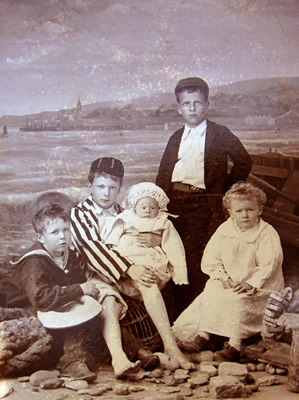 Looking at them inevitably raised the question in our minds, who was Constance and what became of her?
Looking at them inevitably raised the question in our minds, who was Constance and what became of her?
We did not have to wait long! Charlie Morgan-Harris, a young relative from Oxfordshire on holiday in the area came to Wincanton to see the exhibition and then contacted his mother, Mrs Linda Mark, who is married to Constance’s son, Freddie Mark.
Freddie is a retired architect who practiced in Birmingham where he and Linda still live, but they regularly come for holidays to a cottage near Horsington; It was there I met them in August 2014. I was also introduced to his daughters and granddaughter and started to hear what has emerged as quite a story.
They told me that Constance was known as Sis by everyone. This was because she had five brothers and was the only sister. (The photo shows her on the right with four of them.)
She was not sent to school but was taught by a governess, along with her close friend Barbara Hannah, daughter of the Dean of Winchester.
Born in 1890, Constance was twenty-four when she worked in the hospital as an auxiliary 1. During the war the hospital dealt with 898 sick and wounded; and what she saw and heard from those young men as well as those she worked with, during the 5,480 hours she was on duty, must have affected her deeply.
When the war finished and her nursing days were over, she was able to take her passion for art further and left Somerset for London, linking up to live in a flat with Barbara 2. She and Barbara enrolled as art students at the Central School of Arts and Crafts. Central (now merged with St Martin’s Art School to form Central St Martin’s), offered a wide range of design disciplines including theatre, industrial and graphic design. It was difficult for women to study art at this time, as it was considered improper for women to make life-drawings of nude models!
On completing their course she and Barbara held a joint exhibition of their work in London and in early 1920 they decided to set off for Paris, a decision her father supported and made financially possible, for his only daughter was a great favourite. Still, for two single young women to go and live in bohemian and avant-garde Paris was quite an unusual and courageous choice, particularly for someone from their background.
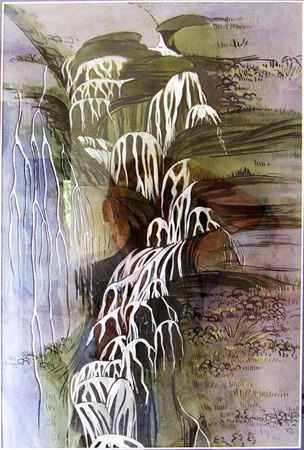 It was there that she had an affair with an English painter and became pregnant, giving birth to Freddie in 1927 when she was 37. Constance and Barbara continued to live together in Paris until Freddy was four. Freddie says his father was never spoken of and he knew nothing about him until much later in his life. Freddie’s birth must have been a shock for the Bailward family and made the thought of returning home to live in Somerset difficult.
It was there that she had an affair with an English painter and became pregnant, giving birth to Freddie in 1927 when she was 37. Constance and Barbara continued to live together in Paris until Freddy was four. Freddie says his father was never spoken of and he knew nothing about him until much later in his life. Freddie’s birth must have been a shock for the Bailward family and made the thought of returning home to live in Somerset difficult.
Constance and Barbara’s next move (in around 1931) was again momentous and unusual. Taking the four year old Freddie with them they set off to live in Kusnacht near Zurich in Switzerland. There Barbara started training with the pioneering psychotherapist and former colleague of Sigmund Freud, Dr Carl Gustav Jung. By this time Jung and Freud had fallen out as Jung had developed his own theories about the subconscious, religion, and the analysis of dreams.
Constance also studied at the Jung Institute and worked on a series of paintings illustrating her dreams, as part of her own analysis. Freddie still owns several of these.
Inspired by the Swiss landscape Constance also produced a series of paintings of waterfalls.
In 1933 everything changed again and Constance returned to England with Freddie, who by then was six and a half. Barbara remained behind working at the Jung Institute. She came back to Horsington because a childhood friend had proposed to her. His name was ‘Frank’ (Francis de Forest) Daniel, the son of the vicar of Horsington and a civil servant in the Colonial Service. Constance accepted his proposal and they were married.
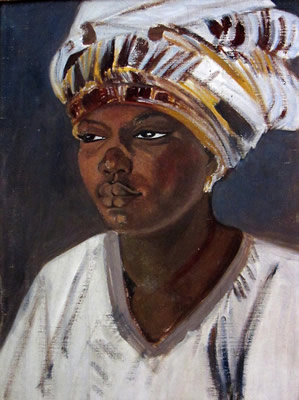 Despite his tender age, as often happened at that time Freddie was considered old enough to board at Sherborne Preparatory School, and Frank and Constance set off for Northern Nigeria, where he was appointed District Commissioner for Kano. Being a Muslim area, with traditional emirs in place, British policy there was to develop indirect rule which required great diplomatic skill. Frank was responsible for administering an area about the size of Wales with an African population of some ten million, carried out with a tiny staff. It involved travelling to remote places while maintaining a constant vigil against contracting malaria or yellow fever; diseases which had earned West Africa the label of being “the white man’s grave”. Constance accompanied him on his tours and there are several fine portraits painted in oils dating from this period. All this was a far cry from bohemian Paris or comfortable Horsington.
Despite his tender age, as often happened at that time Freddie was considered old enough to board at Sherborne Preparatory School, and Frank and Constance set off for Northern Nigeria, where he was appointed District Commissioner for Kano. Being a Muslim area, with traditional emirs in place, British policy there was to develop indirect rule which required great diplomatic skill. Frank was responsible for administering an area about the size of Wales with an African population of some ten million, carried out with a tiny staff. It involved travelling to remote places while maintaining a constant vigil against contracting malaria or yellow fever; diseases which had earned West Africa the label of being “the white man’s grave”. Constance accompanied him on his tours and there are several fine portraits painted in oils dating from this period. All this was a far cry from bohemian Paris or comfortable Horsington.
Frank’s tour of duty came to an end in 1938 and he was then able to retire and they both returned home to Horsington.
During the Second World War Frank was actively involved in civilian defence in the area and was based in Wincanton. Constance used to cycle to Wincanton regularly to help in the WVS canteen in the town.
Constance continued to paint (and had a studio in the attic of her home) and became an enthusiastic exhibiting member of Bruton Art Society when it was founded in 1953.
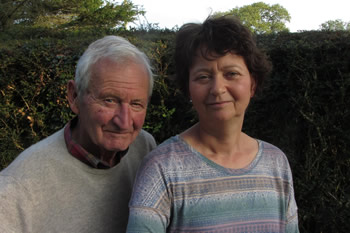 Freddie, seen here with his daughter Sara, remained her only child and Constance died in 1970 at the age of 80, leaving behind several diaries and many drawings and paintings 3. She is remembered as having had a terrific sense of humour and an enormous laugh. She was very energetic in everything she did, loved her garden and was involved with Freddie's children as they were growing up in Bristol and later Birmingham.
Freddie, seen here with his daughter Sara, remained her only child and Constance died in 1970 at the age of 80, leaving behind several diaries and many drawings and paintings 3. She is remembered as having had a terrific sense of humour and an enormous laugh. She was very energetic in everything she did, loved her garden and was involved with Freddie's children as they were growing up in Bristol and later Birmingham.
Freddie, his wife Linda and his daughter Sara, who is also an artist, have been very helpful in assisting me to write this account of Constance.
John Baxter
- Why was Constance a Nursing Auxiliary? In a recent TV interview, Shirley Williams, speaking of her mother Vera Britten, explained that the Army did not approve of young ladies of “good family” nursing young men in case they saw or heard more than was decent, and to put them off refused to let them train properly as nurses, keeping them as auxiliaries. No doubt the work they did was just as demanding.
- Barbara Hannah (1891 – 1986) remained a life-long friend of Constance and became a well-respected member of staff at the Jung Institute and a close colleague of Jung for many years. She practiced as a psychotherapist, lectured, wrote seven books and many articles on Jungian psychology including a key biography of Jung. The books are all still in print.
- Sadly we have no photo of Constance.
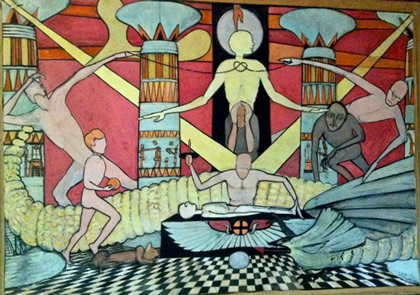
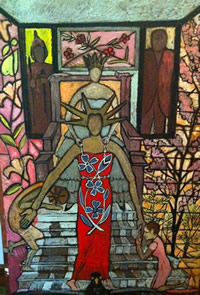
Comments
Login to comment!